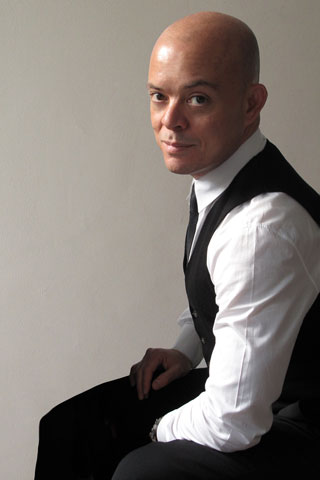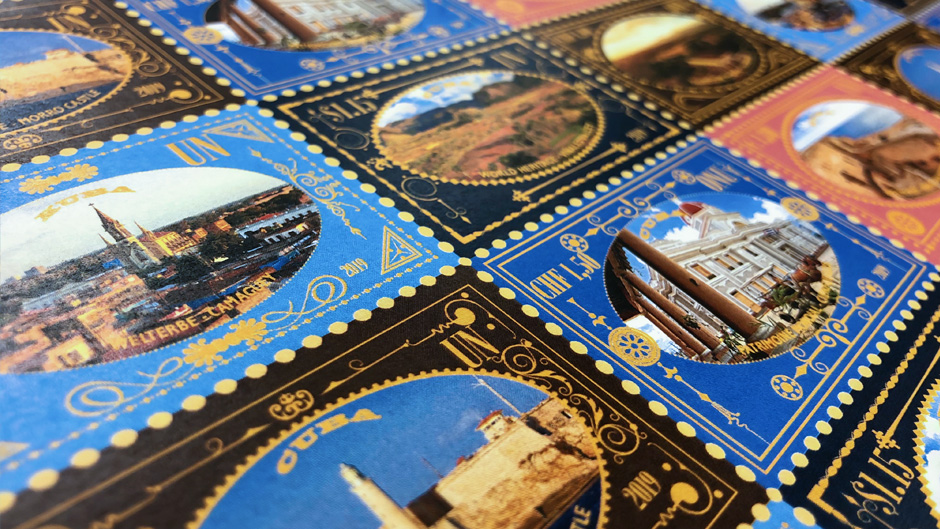When Sergio Baradat was four years old in Guantanamo, Cuba, he was fascinated by the colorful fish swimming in his grandmother’s backyard pond and was inspired to draw them.
Fast forward some 50-odd years and Baradat is still drawn to colors. Vibrant swirls of them adorn many of the stamps, posters and small books that he creates as art director for the United Nations Postal Administration in New York. He designs postage stamps for the United Nations that are collected by philatelists worldwide, as well as mailed by the general public.
Several of Baradat’s stamp designs are part of the University of Miami’s Cuban Heritage Collection (CHC). One of his very special donations to the CHC is a poster engraved with Cuban American poet Richard Blanco’s inaugural poem “One Today,” which the poet read during President Barack Obama’s 2013 inauguration. Blanco and Baradat who are close friends, were very happy to donate a co-signed print to CHC’s collection; a print is also part of President Obama’s collection.
On October 24, the U.N. will unveil six postage stamps with iconic images of Cuba that were designed by Baradat. There are numerous sites in Cuba which are designated UNESCO World Heritage sites. The stamps feature images of the Morro Castle, Viñales Valley and the San Pedro De La Roca Castle in Santiago de Cuba, Trinidad, Cienfuegos and Camagüay.
“I am very proud of my Cuban heritage and having the privilege to work on this project was a joy and a labor of love,” Baradat said.
 Born in Havana, Baradat immigrated to Spain with his parents and eventually settled in New York, then New Jersey. They later moved to Miami where his family opened a pharmacy in Little Havana.
Born in Havana, Baradat immigrated to Spain with his parents and eventually settled in New York, then New Jersey. They later moved to Miami where his family opened a pharmacy in Little Havana.
Both his parents wanted him to enter the medical field, but he followed his passion for art. After attending Miami Dade College, and with a brief stint at Editorial America working as art director for a Spanish fashion magazine, he proceeded to attend Parsons School of Design in New York. While still a student there, his first paying job was to create sketches for a cover illustration for Vanity Fair magazine.
A cousin who spent her childhood with Baradat described him as “a force to be reckoned with.”
“There was no stopping him,” said the cousin. "His talent was always so obvious to everybody.”
That talent blossomed in New York where he continued to do work for G.Q., Vogue, The New York Times, Sony, Simon & Schuster, Time, The New Yorker, The American Music Awards, and The Academy Awards to name a few. His work also included a stint at the National Football League, where he designed collateral material for the enterprise and several Super Bowls.
Seven years ago, Baradat was recruited by the U.N. where his contemporary, stylish designs have graced dozens of stamps. U.N. stamps are issued in three currencies: Dollars, Euros and Swiss Francs; the stamps are issued in three languages: English, French and German. U.N. stamps also address world themes such as climate change, gender equality, Endangered Species, World Heritage sites, and world health, to name but a few.
The U.S. Postal Service has also commissioned Baradat to design stamps. In one of those series, called “Tropical Fruit,” his Caribbean influence is palpable in the colorful, ripe hues used to sketch the fruits. In another series, titled “Let’s Dance,” an elegant couple twirls on a multihued dance floor.
Baradat has been greatly influenced by his Cuban roots and upbringing, as well as the Art Deco architecture of Miami’s South Beach. “We grew up with all those wonderful buildings from the 1920s and 30s,” he said. “I think this planted the seed in me for the appreciation of art between the two World Wars.”
There was also Vizcaya, the James Deering estate on Biscayne Bay, which played a part in molding his sense of style.
In the upcoming World Heritage Cuba Stamp Issue, Baradat wanted to pay homage to the Cuban stamps from the early 20th century. He chose gold foil to frame the images, which is reminiscent of vintage cigar bands.
Although he is a New Yorker, Cuba is never far from his mind.
For additional information about United Nations stamps and to purchase the World Heritage Cuba issue, visit: www.unstamps.org

